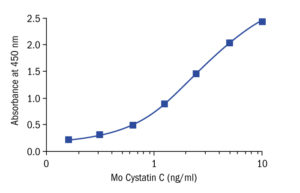Cystatin C Mouse ELISA
Cystatin C is a non-glycosilated basic single-chain protein consisting of 120 amino acids with a molecular weight of 13.36 kDa and is characterized by two disulfide bonds in the carboxy-terminal region. It belongs to the cystatins superfamilly which inactivates lysosomal cysteine proteinases, e.g. cathepsin B, H,.K, L and S. Imbalance between Cystatin C and cysteine proteinases is associated with inflammation, renal failure, cancer, Alzheimer’s disease, multiple sclerosis and hereditary Cystatin C amyloid angiopathy. Its increased level has been found in patients with autoimune diseases, with colorectal tumors and in patients on dyalisis. Serum Cystatin C seems to be better marker of glomerular filtration rate than creatinine. On the other hand, low concentration of Cystatin C presents a risk factor for secondary cardiovascular events.
Features
- It is intended for research use only.
- The total assay time is less than 3.5 hours.
- The kit measures total Cystatin C in mouse serum.
- Assay format is 96 wells.
- Quality Controls are animal serum based. No human sera are used.
- Standard is recombinant protein based.
- Components of the kit are provided ready to use, concentrated or lyophilized.
Research topic
Animal studies, Neural tissue markers, Renal disease
Type
Sandwich ELISA, Biotin-labelled antibody
Applications
Serum
Sample Requirements
5 µl/well
Storage/Expiration
Store the complete kit at 2–8°C. Under these conditions, the kit is stable until the expiration date (see label on the box).
Calibration Curve

Calibration Range
0.156–10 ng/ml
Limit of Detection
0.04 ng/ml
Intra-assay (Within-Run)
n = 8; CV = 7.1%
Inter-assay (Run-to-Run)
n = 5; CV = 8.2%
Spiking Recovery
88,70%
Dilutation Linearity
104,80%
Crossreactivity
| bovine | Non-detectable |
|---|---|
| cat | Non-detectable |
| goat | Non-detectable |
| hamster | Yes (recommended dilution 1:100) |
| horse | Non-detectable |
| dog | Non-detectable |
| monkey | Non-detectable |
| mouse | Yes |
| pig | Non-detectable |
| rabbit | Non-detectable |
| rat | Yes (recommended dilution 1:200) |
| sheep | Non-detectable |
| human | Non-detectable |
| chicken | Not tested |
– Gallo LA, Ward MS, Fotheringham AK, Zhuang A, Borg DJ, Flemming NB, Harvie BM, Kinneally TL, Yeh SM, McCarthy DA, Koepsell H, Vallon V, Pollock C, Panchapakesan U, Forbes JM. Once daily administration of the SGLT2 inhibitor, empagliflozin, attenuates markers of renal fibrosis without improving albuminuria in diabetic db/db mice. Sci Rep. 2016;6:26428
– Jang HR, Gandolfo MT, Ko GJ, Satpute SR, Racusen L, Rabb H. B cells limit repair after ischemic acute kidney injury. J Am Soc Nephrol. 2010 Apr;21 (4):654-65
– Rieger A, Kemter E, Kumar S, Popper B, Aigner B, Wolf E, Wanke R, Blutke A. Missense Mutation of POU Domain Class 3 Transcription Factor 3 in Pou3f3L423P Mice Causes Reduced Nephron Number and Impaired Development of the Thick Ascending Limb of the Loop of Henle. PLoS One. 2016;11 (7):e0158977

